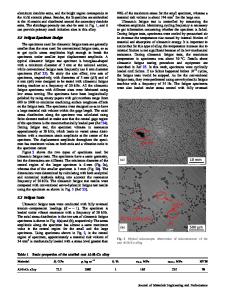High cycle fatigue and fatigue crack growth of the oxide dispersion strengthened alloy MA 754
- PDF / 993,754 Bytes
- 8 Pages / 612 x 792 pts (letter) Page_size
- 85 Downloads / 379 Views
INTRODUCTION
O X I D E dispersion strenthened (ODS) materials are a new class of powder metallurgy high temperature materials. Their excellent high temperature strength makes them attractive for gas turbine blade and vane applications. The alloy MA 754, a Ni-Cr-alloy produced by INCO using mechanical alloying, is of particular interest, z'3 Mechanical alloying is essentially a high energy dry milling operation which introduces a fine dispersion of oxide particles into the material. Apart from the dispersion of oxides, the material is characterized by an elongated grain structure which effectively prevents high temperature grain boundary sliding. Tensile and creep properties of MA 754 have been extensively studied at temperatures up to 1093 °C. 4's~6Recently, the high temperature properties of the same alloy in the ultra fine grain size condition have been investigated. 7 While the behavior of MA 754 under tensile and creep conditions is known, its HCF behavior as well as its relation to subcritical crack growth behavior have not been reported yet. HCF strength is an important factor to be considered in the design of gas turbine components. Moreover, it is often observed for P/M materials that crack growth rates are high and toughness is low even when the fatigue strength is good. s'9"l° The fact that MA 754 alloy as well as the other mechanically alloyed oxide dispersion strengthened alloys exhibit a high degree of texture and anisotropy of grain shape, makes it essential to investigate the HCF and subcritical crack growth behavior in different directions. A susceptibility to form surface porosity due to oxidation has been noticed in ODS materials. "12 The effect of this surface porosity on HCF behavior has not been reported yet. The aim of the present study is to investigate the fatigue crack growth and the HCF behavior of MA 754 as a function of grain orientation at 850 °C. The effect of surface porosity on HCF of MA 754 is also investigated. Part of the M. Y. NAZMY, Scientist, and R. E SINGER, Group Leader, are with Materials Processing Group, Brown Boveri Research Center, CH-5405, Baden, Switzerland. Manuscript submitted September 10, 1984. METALLURGICAL TRANSACTIONS A
results on crack growth rates have been presented in a recent c o n f e r e n c e . 13
II.
EXPERIMENTAL
A. Material The material used in this investigation is INCONEL* *INCONEL is a trademark owned by the INCO family of companies.
alloy MA 754, heat # DT14A3B. The specific composition (in weight percent) is: balance Ni, 20.32 pct Cr, 0.31 pct A1, 0.4 pct Ti, 0.98 pct Fe, 0.05 pct C, 0.001 pct S, 0.57 pct YzO3. Thermomechanical processing results in elongated grains. The undeformed grain structure of MA 754 is shown in Figure 1. The average long grain dimension which is parallel to the rolling direction, as determined from quantitative metallography, is 3.5 mm. The determined average grain aspect ratio of MA 754 used in this investigation is 10.2. The YzO3 dispersoids are unifomlly distributed throughout the matrix. The dispersoids range in
Data Loading...











